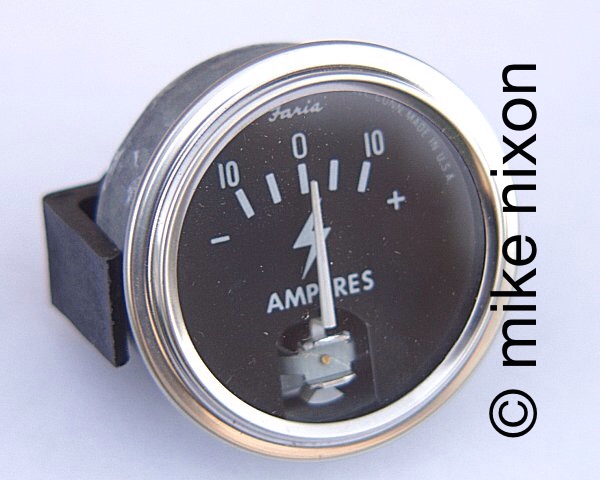  ™ ™I s s u e 1
Yep, Issue number one! Thank you, Motorcycle Project customers! You keep significant vintage Japanese motorbikes in the forefront: current, relevant and interesting. What a great time to be serving this segment of the industry! Here's to our mutual love of 30 to 40 year old classic Asian machinery! 
Hey, heads up! The Motorcycle Project website is completely redesigned for 2016. Take a look, I think you'll like what you see. Especially don't miss all the new goodies in the Parts Shop, including hard to find carburetor rebuilding parts, tools, and other tasty motorcycle bits. One of the newest Motorcycle Project offerings is this motorcycle-sized ammeter. Check it out. Just the right capacity for 70s and 80s bikes, and such a real asset for keeping your bike electrically healthy. Just $23.95! What's an ammeter? Well, I'm glad you asked! To begin with, an ammeter is way different from a voltmeter. You see, the electrical energy coursing though your motorcycle has a couple of important characteristics. One of these is flow. That is, the electricity moves, like the water flowing from a faucet. This flow is often referred to as current, is measured in amperes ("amps") and is the most important aspect of how electricity works on your bike. An ammeter monitors the direction of that flow, something a voltmeter can't do. Nor can a voltmeter respond to changes in flow, but an ammeter shows instantly changes resulting from bad connections and other glitches. Here's an article on the how and why of having an ammeter on board your bike. And here are some other battery related articles on my website, check them out.
As always, the Motorcycle Project is happy to be your go-to source for your carburetor rebuilding needs. I do all Japanese carburetors and have a special love for multicylinders of the 70s and 80s, with CBXs, DOHC fours and Gold Wings a specialty. And since I'm kind of an old fart, I gravitate heavily toward the 70s Honda SOHC fours as well. But I do them all. Quality parts, quality work.
 The 60/40 Rule The 60/40 Rule
There is a troubleshooting technique known in the industry as the "less air/more air" test. Relied on by generations of home-grown mechanics and popularized in recent years by the customer service dept. at Dynojet, it is an easy way to divide the probable cause of an issue into the areas of fuel, electrical and mechanical. It's a classic test, and very effective if done correctly, which is what this article is all about.
To do the test simply duct tape up half of the air filter. Note the performance with the duct tape, and then for good measure reverse the procedure, that is, remove the tape and add some air by propping open the airbox cover or similar. Don't just take the air filter out -- in many bikes this is too much change. Again, note the performance. If the performance symptom did not improve in either case, you can be about 60 percent sure the cause of the symptom is not an intake issue.
But why only 60 percent? The reason is important and it is what I want to emphasize in this article. Even with the high probability of a fuel system issue when the less air test shows positive, 40 percent of the time it's electrical, i.e. ignition. The reason is simply that air/fuel mixture and spark are interdependant. Each needs the other. The air/fuel mixture works best when the spark is vigorous, and the spark is most effective when the air/fuel mixture is potently metered. If either is weak, the other has to compensate to maintain good combustion. If spark is weak, richer mixture is needed to make up for it. If mixture is weak, spark has to be stronger to compensate. They are inverse, or opposites.
Let's see the 60/40 rule in action. I was helping someone troubleshoot their bike. We used the less air test and found its result dramatically positive. The bike revved much better with the duct tape. So, a carburetion problem, right? No, not necessarily. Remember the 60/40 rule. After making sure the carbs were clean, there was good fuel flow to them, the air filters sealed well and were unobstructed, and there was a seal at the manifolds, we turned to the ignition system and found that one of the bike's spark plugs was firing, not at its electrode but down inside the plug, partway down the insulator, at a crack in the insulator. A misfire in other words. The partly drained voltage weakened the spark. The less air test we performed added mixture quantity, making up for the poor spark. This is a classic example of the interdependedness of fuel and ignition, and had we not applied the 60/40 rule we would have gone off on a carburetor tangent, when there was nothing at all wrong with the carburetors. Remmber, just because more fuel gives a positive result does not mean the problem has to be fuel! More of one makes up for less of the other. Don't forget the 60/40 rule.
You can find other issues of the Motorcycle Project Dispatch archived at this link.
| Carbs | Parts | Heads | Electrical | Shocks | Books | Videos |
| Copyright © 2016 The Motorcycle Project |
|

 ™
™
 ™
™